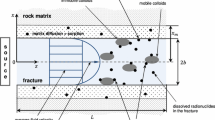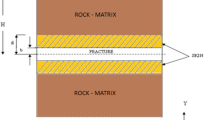Abstract
Transport of colloids in a fractured rock is strongly affected by alterations in the rock matrix, termed as fracture skin. In this work, a colloid transport model is developed to analyze its migration in fractured formations, based on the triple continuum approach, incorporating the fracture skin as the third continuum, besides the fracture and the rock matrix. The system of coupled partial differential equations governing transport in the fractured media is solved using a numerical model employing a fully implicit formulation and based on the finite difference method. Colloid migration in the fractured formation is investigated for both “with” and “without fracture skin” scenarios and for constant concentration and constant flux inlet boundary conditions. Simulations carried out using the model indicate that fracture skin can either enhance or retard colloid migration in a fracture depending on its properties. The porosity and diffusion coefficient of the fracture skin are found to be the critical fracture skin properties affecting the transport of colloids in a fractured medium.
Similar content being viewed by others

References
Abdel-Salam, A. and Chrysikopoulos, C. V. (1994). “Analytical solutions for one-dimensional colloid transport in saturated fractures.” Adv. Water Res., Vol. 17,Issue 5, pp. 283–296.
Champ, D. R. and Schroeter, J. (1988). “Bacterial transport in fractured rock: A field-scale tracer test at the chalk river nuclear laboratories” Water Sci. Technol., Vol. 20, Nos. 11–12, pp. 81–87.
Fu, L., Milliken, K. L., and Sharp, J. M. Jr. (1994). “Porosity and permeability variations in the fractured and liesegang-banded Breathitt sandstone, Middle Pennsylvanian, eastern Kentucky: Diagenetic controls and implications for modelling dual porosity systems.” J. Hydrol., Vol. 154,Issues 1–4, pp. 351–381.
Garner, T. T. and Sharp, J. M. Jr. (2004). “Hydraulic properties of granitic fracture skins and their effect on solute transport.” Proc. 2004 U.S. EPA/NGWA Fractured Rock Conference: State of the science and measuring success in remediation, Maine, pp. 664–678.
Hwang, Y., Pigford, T. H., Lee, W. W. L., and Chambre, P. L. (1990). “Analytic solution of pseudocolloid migration in fractured rock.” Mat. Res. Soc. Symp. Proc., Vol. 176, pp. 599–605.
James, S. C. and Chrysikopoulos, C. V. (2003). “Analytical solutions for monodisperse and polydisperse colloid transport in uniform fractures.” Colloids Surf. A: Physicochem. Eng. Aspects, Vol. 226, No. 1, pp. 101–118.
Kreisel, I. and Sharp, J. M. Jr. (1996). “Fracture skins in the Brushy Canyon Formation.” In: DeMis, W. D. and Cole, A. G. (ed). The Brushy Canyon Play in Outcrop and Subsurface: Concepts and Examples, PBS-SEPM No. 96-38, Midland, TX.
McDowell-Boyer, L. M., Hunt, J. R., and Sitar, N. (1986). “Particle transport through porous media.” Water Resour. Res., Vol. 22, No. 13, pp. 1901–1921.
Mills, W. B., Liu, S., and Fong, F. K. (1991). “Literature review and model (COMET) for colloid/metals transport in porous media.” Ground Water, Vol. 29, No. 2, pp. 199–208.
Moulin, V. and Ouzounian, G. (1992). “Role of colloids and humic substances in the transport of radioelements through the geosphere.” Appl. Geochem. Suppl., Vol. 7,supplement 1, pp. 179–186.
Oswald, J. G. and Ibaraki, M., (2001). “Migration of colloids in discretely fractured porous media: Effect of colloidal matrix diffusion.” J. Contam. Hydrol., Vol. 52,Issues 1–4, pp. 213–244.
Robinson, N. I., Sharp, J. M., and Kreisel, I. (1998). “Contaminant transport in sets of parallel finite fractures with fracture skins.” J. Contam. Hydrol., Vol. 31, Nos. 1–2, pp. 83–109.
Toran, L. and Palumbo, A. V. (1992). “Colloid transport through fractured and unfractured laboratory sand columns.” J. Contam. Hydrol., Vol. 9,Issue 3, pp. 289–303.
Author information
Authors and Affiliations
Corresponding author
Rights and permissions
About this article
Cite this article
Nair, V.V., Thampi, S.G. A triple continuum transport model for colloid migration in fractured formations. KSCE J Civ Eng 16, 293–297 (2012). https://doi.org/10.1007/s12205-012-1336-8
Received:
Revised:
Accepted:
Published:
Issue Date:
DOI: https://doi.org/10.1007/s12205-012-1336-8



